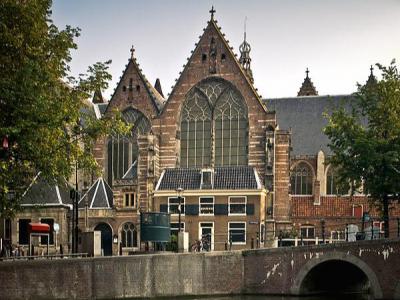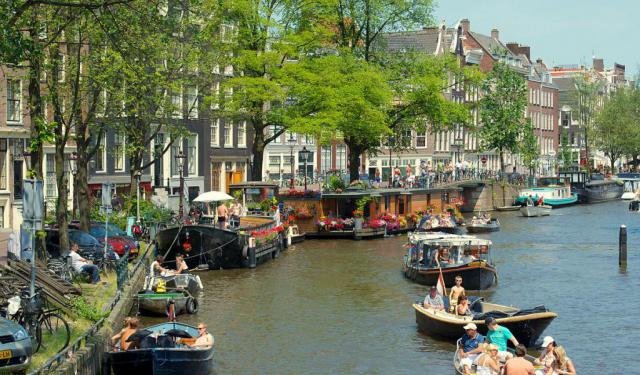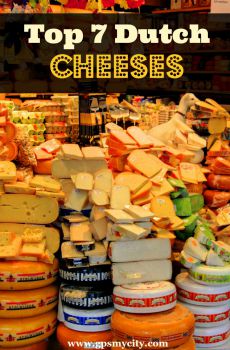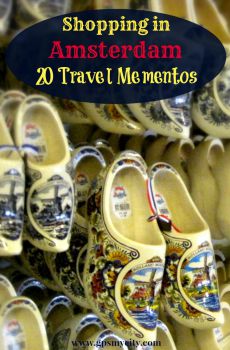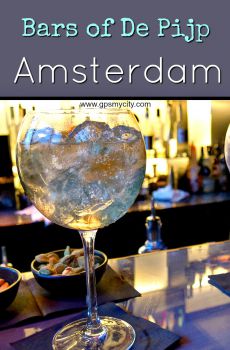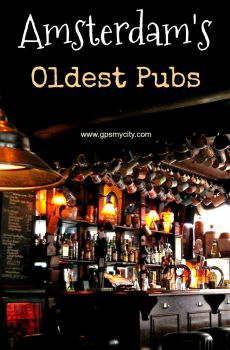
Amsterdam's Historical Churches Walking Tour (Self Guided), Amsterdam
The history of Amsterdam is deeply intertwined with its religious heritage. The city is home to several historical churches, each with its own unique charm and significance. These religious sites serve as both spiritual centers and architectural treasures that provide insight into the city's past.
Our walk starts in the Central Station area and leads you to visit the eight most prominent churches downtown.
One such is the Saint Nicholas Church (Sint Nicolaaskerk), a neo-baroque Catholic temple, whose stunning facade and intricate interior attract those keen on religious art and architecture.
The Old Church (Oude Kerk) is Amsterdam's oldest surviving building, dating back to the early 13th century. This Gothic sanctuary, situated in the heart of the Red Light District, is not only a place of worship but also a cultural hub, hosting concerts and exhibitions.
The Southern Church (Zuiderkerk) is an elegant Renaissance-style building with a distinctive tower. It stands as a testament to Amsterdam's 17th-century prosperity, and its interior is adorned with beautiful metalwork.
The Begijnhof Chapel, nestled within the tranquil Begijnhof courtyard, offers a peaceful retreat from the bustling city. This hidden gem showcases a quaint chapel surrounded by picturesque houses and gardens.
The New Church (Nieuwe Kerk) is known for its grandeur and hosts royal coronations and exhibitions. Its awe-inspiring architecture and historical artifacts make it a significant cultural and religious site.
The Church of Our Lady (Onze-Lieve-Vrouwekerk) is a hidden treasure with a stunning interior adorned with ornate decorations, stained glass windows, and a serene atmosphere.
The Western Church (Westerkerk), with its iconic tower, is a symbol of Amsterdam and offers picturesque views from its top. It is closely associated with the famous Dutch painter Rembrandt, who is buried somewhere inside (the exact location of his grave is unknown).
The Northern Church (Noorderkerk) is an elegant example of Dutch Renaissance architecture. It is a serene place of worship known for its peaceful ambiance.
To truly appreciate Amsterdam's historical churches, taking a leisurely walk on this self-guided tour is highly recommended. Whether you are a keen churchgoer or simply interested in the architectural and historic aspects, Amsterdam will not disappoint. Don't miss the opportunity to explore these cultural treasures and experience the city's past come to life through its churches.
Our walk starts in the Central Station area and leads you to visit the eight most prominent churches downtown.
One such is the Saint Nicholas Church (Sint Nicolaaskerk), a neo-baroque Catholic temple, whose stunning facade and intricate interior attract those keen on religious art and architecture.
The Old Church (Oude Kerk) is Amsterdam's oldest surviving building, dating back to the early 13th century. This Gothic sanctuary, situated in the heart of the Red Light District, is not only a place of worship but also a cultural hub, hosting concerts and exhibitions.
The Southern Church (Zuiderkerk) is an elegant Renaissance-style building with a distinctive tower. It stands as a testament to Amsterdam's 17th-century prosperity, and its interior is adorned with beautiful metalwork.
The Begijnhof Chapel, nestled within the tranquil Begijnhof courtyard, offers a peaceful retreat from the bustling city. This hidden gem showcases a quaint chapel surrounded by picturesque houses and gardens.
The New Church (Nieuwe Kerk) is known for its grandeur and hosts royal coronations and exhibitions. Its awe-inspiring architecture and historical artifacts make it a significant cultural and religious site.
The Church of Our Lady (Onze-Lieve-Vrouwekerk) is a hidden treasure with a stunning interior adorned with ornate decorations, stained glass windows, and a serene atmosphere.
The Western Church (Westerkerk), with its iconic tower, is a symbol of Amsterdam and offers picturesque views from its top. It is closely associated with the famous Dutch painter Rembrandt, who is buried somewhere inside (the exact location of his grave is unknown).
The Northern Church (Noorderkerk) is an elegant example of Dutch Renaissance architecture. It is a serene place of worship known for its peaceful ambiance.
To truly appreciate Amsterdam's historical churches, taking a leisurely walk on this self-guided tour is highly recommended. Whether you are a keen churchgoer or simply interested in the architectural and historic aspects, Amsterdam will not disappoint. Don't miss the opportunity to explore these cultural treasures and experience the city's past come to life through its churches.
How it works: Download the app "GPSmyCity: Walks in 1K+ Cities" from Apple App Store or Google Play Store to your mobile phone or tablet. The app turns your mobile device into a personal tour guide and its built-in GPS navigation functions guide you from one tour stop to next. The app works offline, so no data plan is needed when traveling abroad.
Amsterdam's Historical Churches Walking Tour Map
Guide Name: Amsterdam's Historical Churches Walking Tour
Guide Location: Netherlands » Amsterdam (See other walking tours in Amsterdam)
Guide Type: Self-guided Walking Tour (Sightseeing)
# of Attractions: 8
Tour Duration: 2 Hour(s)
Travel Distance: 3.8 Km or 2.4 Miles
Author: clare
Sight(s) Featured in This Guide:
Guide Location: Netherlands » Amsterdam (See other walking tours in Amsterdam)
Guide Type: Self-guided Walking Tour (Sightseeing)
# of Attractions: 8
Tour Duration: 2 Hour(s)
Travel Distance: 3.8 Km or 2.4 Miles
Author: clare
Sight(s) Featured in This Guide:
- Sint Nicolaaskerk (St. Nicholas Church)
- Oude Kerk (Old Church)
- Zuiderkerk (Southern Church)
- Begijnhof Chapel
- Nieuwe Kerk (New Church)
- Onze-Lieve-Vrouwekerk (Church of Our Lady)
- Westerkerk (Western Church)
- Noorderkerk (Northern Church)
1) Sint Nicolaaskerk (St. Nicholas Church)
On the opposite side of the water from Stationsplein, you'll spot Saint Nicholas with its twin towers and dome – it's Amsterdam's main Catholic church, dedicated to the patron saint of sailors and the city itself. Similar to the Central Station, it's been around since the 1880s, and its design draws from a blend of revival styles, with Neo-Baroque and Neo-Renaissance being the most prominent influences.
Inside, you'll find a vast space adorned with religious murals that some might find a bit sentimental, although the colorful brickwork does provide relief. Above the main altar, you can't miss the crown of Habsburg Emperor Maximilian – a significant symbol of the city that you'll come across repeatedly. Amsterdam had quite a connection with Maximilian – back in the late 15th century, he visited as a pilgrim and stayed on to recover from an illness. The city's residents even supported many of his military ventures, and in return, he allowed Amsterdam to incorporate his crown into its coat of arms. Surprisingly, this tradition survived the 17th-century revolt against Spain.
Inside, you'll find a vast space adorned with religious murals that some might find a bit sentimental, although the colorful brickwork does provide relief. Above the main altar, you can't miss the crown of Habsburg Emperor Maximilian – a significant symbol of the city that you'll come across repeatedly. Amsterdam had quite a connection with Maximilian – back in the late 15th century, he visited as a pilgrim and stayed on to recover from an illness. The city's residents even supported many of his military ventures, and in return, he allowed Amsterdam to incorporate his crown into its coat of arms. Surprisingly, this tradition survived the 17th-century revolt against Spain.
2) Oude Kerk (Old Church)
The Oude Kerk, or "Old Church", even by Dutch historical standards, boasts a remarkable antiquity and intriguingly resides within the vibrant precincts of vice – the immensely popular Red Light District of De Wallen. Reconstructed as a modest stone hall church during the 14th century, the structure gradually expanded over time, evolving into a formidable Gothic basilica. Today, it serves as the home of an art institute, a transformation that took place in 2012.
Recognized as the sole structure in Amsterdam to retain its original form since Rembrandt's era, this building serves as the eternal resting place for over 10,000 denizens of Amsterdam. Among them lie illustrious individuals such as Jacob van Heemskerck, a revered naval hero, Frans Banning Cocq, the central character in Rembrandt's iconic painting "The Night Watch," and Jan Sweelinck, renowned for his compositions encompassing all 150 Psalms and achieving international renown as a leading Dutch composer.
Inside, you'll discover a collection of exquisite stained glass, rare ceiling paintings, and a world-renowned organ, crafted by the German Christian Vater in 1724, which is acclaimed as one of the most exceptional Baroque organs across Europe. Additionally, the space frequently serves as a backdrop for art exhibitions and live performances.
Tip:
Wonderful views from the tower (note the fee payable with credit/debit cards only); coffee and snacks in a charming garden.
Recognized as the sole structure in Amsterdam to retain its original form since Rembrandt's era, this building serves as the eternal resting place for over 10,000 denizens of Amsterdam. Among them lie illustrious individuals such as Jacob van Heemskerck, a revered naval hero, Frans Banning Cocq, the central character in Rembrandt's iconic painting "The Night Watch," and Jan Sweelinck, renowned for his compositions encompassing all 150 Psalms and achieving international renown as a leading Dutch composer.
Inside, you'll discover a collection of exquisite stained glass, rare ceiling paintings, and a world-renowned organ, crafted by the German Christian Vater in 1724, which is acclaimed as one of the most exceptional Baroque organs across Europe. Additionally, the space frequently serves as a backdrop for art exhibitions and live performances.
Tip:
Wonderful views from the tower (note the fee payable with credit/debit cards only); coffee and snacks in a charming garden.
3) Zuiderkerk (Southern Church)
One of the most beautiful towers in Amsterdam, which even served as an inspiration for some of Monet's paintings, stands at the location of the Southern Church, known as the Zuiderkerk. Erected between 1603 and 1614, this church holds the distinction of being the first one in Amsterdam constructed exclusively for the Protestant faith. Responsible for its design was renowned architect and sculptor, Hendrick de Keyser, whose distinctive and highly popular style blended elements of traditional Flemish architecture with intricate embellishments, including ornate towers wherever possible. While the main body of the church adheres to a Gothic design, the towering spire exemplified his craftsmanship, featuring balconies, balustrades, arches, urns, and columns.
The Southern Church not only served as a source of inspiration, a model, and a symbol for some but also played an unexpected role as a morgue for the city at one point. During the harsh final years of the Second World War (1944–45), Amsterdam faced a severe shortage of food, leading to a situation where people were passing away more rapidly than they could be interred.
The famous Dutch painter Rembrandt is closely tied to this church in multiple ways, as three of his children found their final resting place here. Due to the proximity of Rembrandt's former residence to the location, there is even speculation that he completed some of his most renowned works within the church premises rather than in his studio.
Today, the building functions as a Municipal Exhibition Center, hosting a variety of events, concerts, and conferences.
The Southern Church not only served as a source of inspiration, a model, and a symbol for some but also played an unexpected role as a morgue for the city at one point. During the harsh final years of the Second World War (1944–45), Amsterdam faced a severe shortage of food, leading to a situation where people were passing away more rapidly than they could be interred.
The famous Dutch painter Rembrandt is closely tied to this church in multiple ways, as three of his children found their final resting place here. Due to the proximity of Rembrandt's former residence to the location, there is even speculation that he completed some of his most renowned works within the church premises rather than in his studio.
Today, the building functions as a Municipal Exhibition Center, hosting a variety of events, concerts, and conferences.
4) Begijnhof Chapel
In Amsterdam, the beguines, devout Catholic women who remained unmarried, may have lost their original church to the rise of Calvinism, which led to the establishment of the current English Reformed Church in the city. However, in accordance with the terms of the 'Alteratie', which was then part of the larger conflict between Protestantism and Catholicism in Europe, they were granted the opportunity to discreetly conduct Mass in the secret Catholic Begijnhof Chapel, which was set up in a house situated directly across from their former church. Initially consecrated to Saint John the Baptist, it was subsequently rededicated to Saint Ursula, the patron saint of the beguines. This quaint little chapel is still in use today, adorned with rather sentimental religious paintings, a splendid altar featuring a depiction of the Last Supper, and an array of other religious artworks and relics.
The adjacent peaceful courtyard, which dates back to 1346, served as the residence for beguines who led a semi-monastic life in service to the community (the last beguine passed away in 1970). Nowadays, the little gabled houses in Begijnhof, constructed between the 14th and 17th centuries, provide homes for elderly retired women, so it's advisable to be respectful of their privacy. During springtime, the Begijnhof lawn is adorned with a colorful carpet of daffodils and crocuses, enhancing the tranquil and spiritual ambiance of the place.
Tip:
For those interested, you can find Het Houten Huys ("The Wooden House") just across the courtyard's lawn. This remarkable structure, dating back to 1425, is the oldest house in Amsterdam and one of only two surviving wooden residences in the city.
The adjacent peaceful courtyard, which dates back to 1346, served as the residence for beguines who led a semi-monastic life in service to the community (the last beguine passed away in 1970). Nowadays, the little gabled houses in Begijnhof, constructed between the 14th and 17th centuries, provide homes for elderly retired women, so it's advisable to be respectful of their privacy. During springtime, the Begijnhof lawn is adorned with a colorful carpet of daffodils and crocuses, enhancing the tranquil and spiritual ambiance of the place.
Tip:
For those interested, you can find Het Houten Huys ("The Wooden House") just across the courtyard's lawn. This remarkable structure, dating back to 1425, is the oldest house in Amsterdam and one of only two surviving wooden residences in the city.
5) Nieuwe Kerk (New Church)
Contending for eminence alongside the Royal Palace, one finds the neighboring New Church. Despite its name, which may misleadingly suggest novelty, this structure is an exemplar of the 15th-century late Gothic style, adorned with an array of soaring pinnacles and gracefully lofty gables. Since the early 19th century, it has served as the venue for every Dutch monarch's coronation.
Over time, this Gothic-style structure incorporated some early Renaissance elements while remaining without a tower. The intricately adorned stained glass windows portray historical events linked to the church, such as Queen Wilhelmina's coronation. Notable features within the interior encompass an opulent, meticulously crafted mahogany pulpit (the result of fifteen years of painstaking effort), alongside a cunningly wrought copper chancel screen and a flamboyant Baroque organ case.
Although the Nieuwe Kerk is still utilized for recitals, it no longer hosts religious services and has transformed into a popular exhibition space. The exhibitions held here cover diverse themes, including some rather unconventional ones. A museum store within offers postcards, books, and gifts, while an adjacent café named the Nieuwe Café boasts a spacious outdoor terrace.
Why You Should Visit:
A must-see if you have an appreciation for historic architecture and a general interest in history.
While you can enter the lobby to admire the magnificent stained glass windows, don't expect a profoundly religious experience.
Over time, this Gothic-style structure incorporated some early Renaissance elements while remaining without a tower. The intricately adorned stained glass windows portray historical events linked to the church, such as Queen Wilhelmina's coronation. Notable features within the interior encompass an opulent, meticulously crafted mahogany pulpit (the result of fifteen years of painstaking effort), alongside a cunningly wrought copper chancel screen and a flamboyant Baroque organ case.
Although the Nieuwe Kerk is still utilized for recitals, it no longer hosts religious services and has transformed into a popular exhibition space. The exhibitions held here cover diverse themes, including some rather unconventional ones. A museum store within offers postcards, books, and gifts, while an adjacent café named the Nieuwe Café boasts a spacious outdoor terrace.
Why You Should Visit:
A must-see if you have an appreciation for historic architecture and a general interest in history.
While you can enter the lobby to admire the magnificent stained glass windows, don't expect a profoundly religious experience.
6) Onze-Lieve-Vrouwekerk (Church of Our Lady)
The beautiful and evocative neo-Gothic design of this Roman Catholic church, featuring its huge brick facade dating back to 1854, is undeniably pleasing to the eye and commands attention in its surroundings, offering some fantastic photo opportunities. Notably, it lacks a tower but compensates with a lavish interior adorned with large paintings and intricate carvings. Literally every nook and cranny and column is painted, and the stained glass windows only add to the grandeur.
Gothic architecture held a special significance for Catholics, as it represented the glorious era of majestic cathedrals within Catholicism. In December 1854, the Catholic publication 'De Tijd' commended the newly constructed church in the following terms: "The Church of Our Lady stands as a testament to the marvels of Gothic architecture. Within its walls, one encounters no mishmash of discordant styles and orders, a regrettable sight often witnessed in various church edifices, including those of more recent origin. This architectural style radiates purity and harmony among its diverse elements, coming together to form a breathtaking entirety that leaves an indelible mark on all who cross its sacred threshold. The facade, too, is a masterpiece, gracing the Keizersgracht."
In 1985, the church was handed over to the Syrian Orthodox Church, yet it remains a place of worship for Catholic services. For those seeking Sunday Mass, the church is accustomed to accommodating tourists and conducts services in English as well.
Gothic architecture held a special significance for Catholics, as it represented the glorious era of majestic cathedrals within Catholicism. In December 1854, the Catholic publication 'De Tijd' commended the newly constructed church in the following terms: "The Church of Our Lady stands as a testament to the marvels of Gothic architecture. Within its walls, one encounters no mishmash of discordant styles and orders, a regrettable sight often witnessed in various church edifices, including those of more recent origin. This architectural style radiates purity and harmony among its diverse elements, coming together to form a breathtaking entirety that leaves an indelible mark on all who cross its sacred threshold. The facade, too, is a masterpiece, gracing the Keizersgracht."
In 1985, the church was handed over to the Syrian Orthodox Church, yet it remains a place of worship for Catholic services. For those seeking Sunday Mass, the church is accustomed to accommodating tourists and conducts services in English as well.
7) Westerkerk (Western Church)
Anne Frank found solace in the soothing chimes of the Western Church's bells, a reminder of the world beyond her hidden refuge, until these very bells were requisitioned for the German war effort. The church, a dominating presence in the neighborhood, continues to stand tall with its 85-meter tower, the Westertoren, undeniably the most splendid in all of Amsterdam. Gracefully rising above its surroundings, it treats visitors to breathtaking panoramic vistas of the city center from its balconies and also boasts a carillon that chimes every quarter-hour (along with full melodic tunes during other intervals). At its pinnacle rests the crown of Emperor Maximilian, an enduring symbol of Amsterdam and the crowning jewel of the city's second church expressly constructed for Protestants. Designed by Hendrick de Keyser and completed a decade after his demise in 1631, the church's creation was an integral part of the city's expansion.
While the exterior exudes deliberate elegance, the interior adheres to the Calvinist congregation's austere principles. Apart from the expansive plain-glass windows that allow abundant natural light to flood in, significant features include a grand Baroque organ and an ornate wooden pulpit crowned by an oversized sounding board—once a platform for Protestant ministers who delivered lengthy sermons. While the merchant elite shunned "idolatrous" embellishments, they asserted their social status with boxed-in benches at the base of several stone columns in the nave, reserved for and rented by the affluent.
Pro Tip:
If you don't mind a cardio workout, the tower ascent, open from April to October, promises a spectacular experience. It not only allows for an up-close encounter with the bells but also provides breathtaking views from the platform near the summit, offering a sweeping vista of much of Amsterdam. While the stairs leading to the uppermost level are quite steep, they are not excessively demanding.
While the exterior exudes deliberate elegance, the interior adheres to the Calvinist congregation's austere principles. Apart from the expansive plain-glass windows that allow abundant natural light to flood in, significant features include a grand Baroque organ and an ornate wooden pulpit crowned by an oversized sounding board—once a platform for Protestant ministers who delivered lengthy sermons. While the merchant elite shunned "idolatrous" embellishments, they asserted their social status with boxed-in benches at the base of several stone columns in the nave, reserved for and rented by the affluent.
Pro Tip:
If you don't mind a cardio workout, the tower ascent, open from April to October, promises a spectacular experience. It not only allows for an up-close encounter with the bells but also provides breathtaking views from the platform near the summit, offering a sweeping vista of much of Amsterdam. While the stairs leading to the uppermost level are quite steep, they are not excessively demanding.
8) Noorderkerk (Northern Church)
The Northern Church stands prominently at the intersection of Noordermarkt (Northern Market), serving as a notable landmark within the neighborhood. This unadorned church holds historical significance as one of the earliest constructions following the Protestant Reformation and represents the final architectural work attributed to Hendrick de Keyser. Surprisingly distinct in style from his other notable churches in the city, namely the Southern and Western churches, it was erected to cater to the impoverished residents of the Jordaan neighborhood. It takes the form of an austere brick structure, characterized by its short spire and bulky, somewhat imposing appearance—a stark departure from the prevailing church designs of the era.
Constructed with a stark, austere appearance, it featured a squat spire and a rather imposing, bulky structure, deviating radically from the conventional church architectural norms of its time. Notably, it adopted a symmetrical Greek cross floor plan, with four arms of equal dimensions extending from a central steeple. This unyieldingly somber design underscored the solemn commitment of the Calvinist congregation that gathered here. The positioning of the pulpit at the center, rather than the front of the church, symbolized a deliberate departure from Catholic traditions.
Visitors can enjoy weekly concerts at Noorderkerk every Saturday at 2pm, scheduled from June to September.
Constructed with a stark, austere appearance, it featured a squat spire and a rather imposing, bulky structure, deviating radically from the conventional church architectural norms of its time. Notably, it adopted a symmetrical Greek cross floor plan, with four arms of equal dimensions extending from a central steeple. This unyieldingly somber design underscored the solemn commitment of the Calvinist congregation that gathered here. The positioning of the pulpit at the center, rather than the front of the church, symbolized a deliberate departure from Catholic traditions.
Visitors can enjoy weekly concerts at Noorderkerk every Saturday at 2pm, scheduled from June to September.
Walking Tours in Amsterdam, Netherlands
Create Your Own Walk in Amsterdam
Creating your own self-guided walk in Amsterdam is easy and fun. Choose the city attractions that you want to see and a walk route map will be created just for you. You can even set your hotel as the start point of the walk.
City Center Walking Tour
The inner-most borough and historic heart of Amsterdam, known locally as Centrum, is a tightly woven network of canals and overlapping micro-neighborhoods, each bursting with their own unique vibe and history. Formerly a working-class area, this district is reputed for its traditional community spirit, radical politics and historic brown bars.
Here, all within an easy walking distance you will... view more
Tour Duration: 2 Hour(s)
Travel Distance: 2.3 Km or 1.4 Miles
Here, all within an easy walking distance you will... view more
Tour Duration: 2 Hour(s)
Travel Distance: 2.3 Km or 1.4 Miles
Southern Canal Belt Walking Tour
The Canal District, known as Grachtengordel in Dutch, is a globally renowned example of urban planning and architectural excellence within Amsterdam. This area has remained remarkably well-preserved for over four centuries, celebrated for its charming small bridges, canal crossings, and 17th-century residences. Encircling the Old City Centre in a horseshoe shape, the Canal Ring encompasses three... view more
Tour Duration: 2 Hour(s)
Travel Distance: 3.1 Km or 1.9 Miles
Tour Duration: 2 Hour(s)
Travel Distance: 3.1 Km or 1.9 Miles
Amsterdam Food Tour
Amsterdam's food scene is a delightful fusion of local traditions and global influences. Making your way through the interlocking canals, pretty bridges, and a maze of streets laden with diverse eateries and bars may easily render you hankering for a bite to eat and/or a drink to wash it down with.
The diverse culinary landscape of Amsterdam caters to a wide range of tastes and... view more
Tour Duration: 2 Hour(s)
Travel Distance: 2.6 Km or 1.6 Miles
The diverse culinary landscape of Amsterdam caters to a wide range of tastes and... view more
Tour Duration: 2 Hour(s)
Travel Distance: 2.6 Km or 1.6 Miles
Jewish Quarter Walking Tour
The Jodenbuurt (Jewish Quarter) of Amsterdam had been the center of the Dutch Jewish community from the 16th century up until the Second World War. The neighborhood is best known as the birthplace of Baruch Spinoza, the home of Rembrandt, and the Jewish ghetto under the Nazi occupation of the Netherlands.
Once crowded with open-air stalls, smoking factories and tenement buildings, the Old... view more
Tour Duration: 2 Hour(s)
Travel Distance: 2.0 Km or 1.2 Miles
Once crowded with open-air stalls, smoking factories and tenement buildings, the Old... view more
Tour Duration: 2 Hour(s)
Travel Distance: 2.0 Km or 1.2 Miles
Amsterdam Introduction Walking Tour
“Dancing to its own beat,” the Dutch capital Amsterdam is famous for its unusual life rhythm that is manifested in the air of canals, coffee shops, and the Red Light District, as well as many other things that altogether draw annually over five million visitors to the city.
A place where “hipness meets history”, Amsterdam emerged in the late 12th century as a small fishing village... view more
Tour Duration: 3 Hour(s)
Travel Distance: 5.1 Km or 3.2 Miles
A place where “hipness meets history”, Amsterdam emerged in the late 12th century as a small fishing village... view more
Tour Duration: 3 Hour(s)
Travel Distance: 5.1 Km or 3.2 Miles
Jordaan Walking Tour
The Jordaan district of Amsterdam is a popular neighborhood renowned for its charming, narrow streets, quaint courtyards, and picturesque canals. Replete with beautiful historic houses, many of which have been converted into cozy cafés, trendy boutiques, and art galleries, this district has a distinctive atmosphere that sets it apart from other areas in the city.
The Jordaan was originally... view more
Tour Duration: 1 Hour(s)
Travel Distance: 2.4 Km or 1.5 Miles
The Jordaan was originally... view more
Tour Duration: 1 Hour(s)
Travel Distance: 2.4 Km or 1.5 Miles
Useful Travel Guides for Planning Your Trip
12 Traditional Dutch Foods You Must Try in Amsterdam
Cool climate, closeness to sea, and sense of adventure have made the Dutch what they are – skillful farmers, industrious seafarers and, generally, people with the taste for life and good hearty meal, whether it comes from the sea they live by or the land they set their feet on. All of this has...
Top 7 Dutch Cheeses to Try in Amsterdam
Don't mind things turning a bit "cheesy" when in Holland. After all, this small country is renowned for its cheese manufacturing and successfully competes, in terms of cheese exports, with such economic giants as the United States and Germany. Amsterdam alone and its vicinities are...
Souvenir Shopping in Amsterdam: 20 Dutch Things To Buy
Tulips, red lights, weed... Other than these, there are plenty of good things to remember Amsterdam by. What's more, you can take home some of them quite legally. Look here to see what to buy in Amsterdam and...
Bars of De Pijp, Amsterdam
Sitting to the south of the Centrum (city centre) De Pijp area of Amsterdam is a fascinating mixture of trendy urbanites, students, immigrants and Amsterdammers. De Pijp has a long history as the Bohemian part of town, which is reflected in the different cafés of the area. There truly is something...
The Oldest and Historic Pubs of Amsterdam
Amsterdam is a stunningly beautiful city, steeped in history, with hidden treasures and fascinating tales practically around every corner. Like all marvelous cities, Amsterdam has its share of dining and drinking establishments from the modern to the ancient. This guide will assist you in exploring...
Dutch Sweets and Pastries
Known primarily for their cheeses, the Dutch have proven just as passionate about their sweets and pastries, many of which have come about as a result of the centuries of colonial past that had infused Holland with Oriental flavors and ingredients. Blended with their own dairy-rich European...
The Most Popular Cities
/ view all

